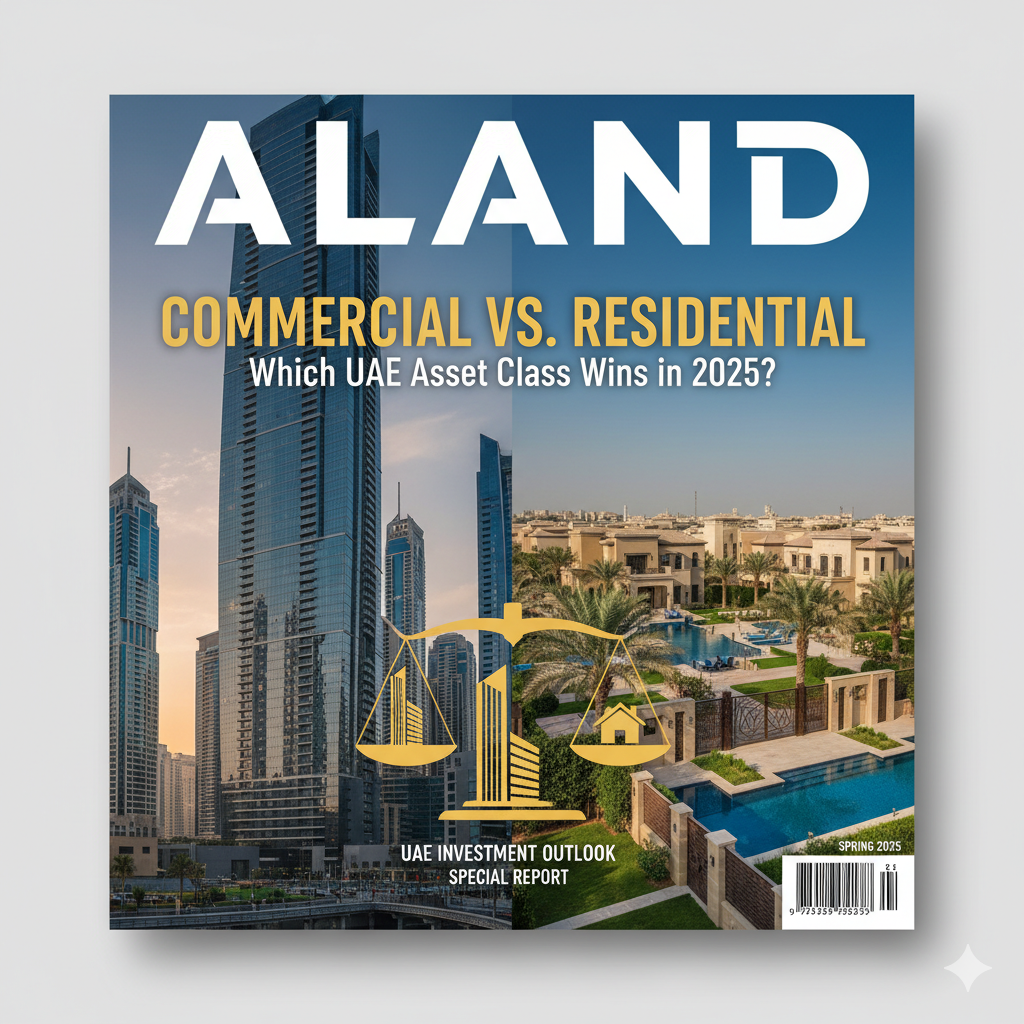Commercial vs. Residential: Which UAE Asset Class Wins in 2025?
- Published Date: 23 Oct, 2025
-
4.9★ ★ ★ ★ ★(97)

Market Dynamics and Economic Context Commercial real estate in the UAE, encompassing office spaces, retail centers, and logistics hubs, thrives on the nation’s status as a global trade and tourism hub. In 2025, Dubai’s Expo City and Abu Dhabi’s Masdar City continue to attract multinational corporations, driving demand for premium office spaces. ALand’s blog highlights a 12% year-on-year increase in commercial lease rates in Dubai’s DIFC, fueled by tech and finance firms. However, commercial investments face headwinds from global economic uncertainties, including fluctuating oil prices and interest rate hikes, which could dampen corporate expansion plans.
Residential real estate, conversely, benefits from the UAE’s growing expatriate population and favorable immigration policies. Dr. Ghamari, whose work in immigration economics informs this perspective, notes that relaxed visa regulations and golden visa programs have spurred demand for luxury villas and mid-tier apartments. Data from The ALand Times indicates a 15% rise in residential transactions in Dubai’s Palm Jumeirah and Downtown areas, reflecting strong investor confidence. Yet, oversupply risks in certain mid-market segments could pressure rental yields.
Strategic Advantages of Commercial Investments Commercial properties offer higher rental yields—often 7-10% annually compared to residential’s 5-7%—making them attractive for institutional investors. Dr. Ghamari emphasizes the role of digital economy transformations, such as smart building technologies, in enhancing commercial asset value. For instance, logistics hubs near Jebel Ali Port are seeing increased demand due to e-commerce growth, a trend amplified by the UAE’s push for digital trade corridors.
However, commercial investments require significant capital and longer lease terms, exposing investors to market volatility. Global macroeconomic signals, such as U.S. Federal Reserve rate decisions, could impact corporate budgets, reducing demand for office spaces. Dr. Ghamari advises diversifying portfolios with mixed-use developments to mitigate risks, blending retail, office, and residential components for stable cash flows.
Residential Real Estate: Stability and Sentiment Residential properties appeal to investors seeking stability and emotional resonance. Dr. Ghamari highlights that homeownership aligns with the UAE’s vision of long-term residency, fostering brand loyalty among developers who prioritize community-centric projects. ALand’s blog cites Emaar Properties’ success in integrating green spaces and wellness amenities, boosting buyer sentiment by 20% in surveys. Residential investments also benefit from lower entry costs, with off-plan properties offering flexible payment plans.
Yet, residential markets face challenges from regulatory shifts and speculative buying. The ALand Times reports tightened mortgage regulations in 2025 to curb overheating, potentially slowing transaction volumes. Dr. Ghamari advocates using ALand’s digital tools to analyze cash flow projections, helping investors identify undervalued properties in emerging areas like Dubai South.
Innovative Investment Avenues: Tokenization and EE Gold Dr. Ghamari’s expertise in financial innovation points to tokenization as a game-changer for both asset classes. By fractionalizing property ownership through blockchain. Similarly, residential properties in Abu Dhabi’s Saadiyat Island are being tokenized, democratizing access. EE Gold, a cryptocurrency pegged to physical gold, offers a hedge against real estate market volatility. Dr. Ghamari notes that EE Gold’s stability—unlike traditional cryptocurrencies—makes it a viable tool for cross-border property transactions, reducing reliance on volatile fiat currencies.
Practical Takeaways for Investors
- Portfolio Diversification: Allocate 60% to commercial assets for higher yields and 40% to residential for stability, adjusting based on risk tolerance.
- Explore Tokenization: Invest in tokenized assets to access premium properties with lower capital outlays.
- Monitor Macro Signals: Track global interest rates and UAE policy changes via The ALand Times to anticipate market shifts.
- Focus on Sustainability: Prioritize ESG-compliant properties, as 68% of UAE investors prefer green-certified buildings, per ALand’s blog.
Measurable outcomes include a potential 8-12% ROI for commercial properties with strategic tenant mixes and 6-9% for residential units in high-demand areas. Brand sentiment improves when developers align with UAE’s sustainability goals.

